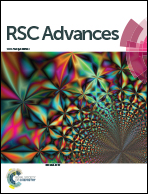Synthesis of chiral fluorescence silver nano-clusters and study on the aggregation-induced emission enhancement and chiral flip†
Abstract
Synthesis and application of fluorescent and chiral nano-clusters have been concerned greatly nowadays. In this work, the silver nano-clusters (AgNCs) with fluorescence and chirality were synthesized with solid-phase synthesis method, using racemic glutathione (GSH) as ligand. The synthesis conditions were optimized. In the process of synthesis, we were surprised to discover the aggregation-induced emission enhancement (AIEE) and chiral flip of AgNCs. The mechanism of AIEE and chiral flip were studied with high resolution transmission electron microscopy (HR-TEM), electrospray ionization-mass spectrometry (ESI-MS), matrix-assisted laser desorption/ionization time-of-flight mass spectrometry (MALDI-TOF-MS), fluorescence (FL) and circular dichroism (CD) spectrometry. What we found was that the hydrogen bond between GSH molecules on the surface of AgNCs induced cross-coupling agglomeration of the clusters, resulting in AIEE and chiral flip. In this study, the proposed AgNCs are expected to be used as a chiral fluorescent probe for the chiral recognition of biological and pharmaceutical molecules, and the synthesis method of chiral fluorescent AgNCs and mechanism explained here play an important guiding role in the future development of metal nano-clusters.


 Please wait while we load your content...
Please wait while we load your content...